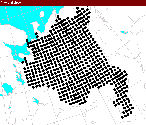 Range of Larix sibirica (9). | Larix sibirica Ledebour 1833Common NamesSiberian larch, Russian larch (7).Taxonomic notesSyn: L. sukaczewii (Dylis) 1981 (1); L. russica (Endl.) Sabine ex Trautv. 1884; L. decidua var. russica Henkel and Hockstetter; L. decidua var. sibirica (Ledebour) Regel; L. intermedia Fischer ex. Turczaninow; Pinus larix var. russica Endlicher; P. intermedia (Fischer) Turczaninow; P. ledebouri (Ruprecht) Endlicher; Abies ledebourii Ruprecht (7).The synonym L. sibirica is widely used in the Russian literature. L. sukaczewii is segregated from L. sibirica on the basis of morphological distinctions that vanish in some areas and are likely indicative of environmental rather than phylogenetic differences. It is found west of the Urals and in some western Siberian regions bordering the Urals. L. sibirica occupies habitats in Siberia from the Urals east to between the Yenisei River (in the N) and far E Irkutsk. There is a wide zone of hybridization with L. gmelinii (the hybrids sometimes called L. x czekanowski [6]). Before 1981, larches in the range of L. sukaczewii were divided into the subspecies L. sibirica ssp. rossica (Sab.) Suk. in N and NE portions of European Russia and L. sibirica ssp. obensis Suk. in the Ob' River basin, excepting the Altai. Other subspecies sometimes encountered in the literature include L. sibirica ssp. altaica (Szafer) Suk. in the Altai, L. sibirica ssp. jeniseensis Suk. in the Jenisey River basin, L. sibirica ssp. sayanensis Dylis in the Sayans area, L. sibirica ssp. polaris in the upper Lena River basin and regions of Irkutsk Pryangarje, L. sibirica ssp. baicalensis Dylis along the SW and SE coasts of Lake Baikal, and L. sibirica ssp. transbaikalensis in the western Zabaikalje Mountains (5). Description"A tree [24-30 m] high, with a trunk up to [116 cm dbh] in Siberia. Bark as in the European larch. YOUNG SHOOTS more or less hairy, occasionally without down. BUDS rounded or conical, resinous, scales with ciliated margins. BUDS of short shoots surrounded by a dense ring of hairs. LEAVES [2.5-5 cm] or more in length, slender, sharp-pointed, deeply keeled on the under-surface. STROBILI very like those of L. decidua. CONES with fewer scales than in L. decidua; scales 4-sided, as long as broad, outer surface finely striate, hairy, bracts hidden by the scales. SEED and wing up to [13 mm] long. This species is very similar to L. decidua, differing chiefly in its more slender leaves ... and differently shaped cone-scales" (7).RangeRussia: Siberia (2). Found at up to 74° N on the Taymyr Peninsula (var. kayanderi) (4). "In Siberia it is said to occur as small groups mixed with other trees rather than as pure forest" (7). It has been planted for timber production in Finland and Sweden (7).Big TreeExceptionally large specimens on the Kozhym River, Ural Mts. (48 m tall, 360 cm dbh) and the Bogd-Uul Mt., Mongolia (49 m tall, 300 cm dbh) (4).OldestOne tree-ring chronology, presumably based on living tree material, covers 427 years (8).DendrochronologyCollections have been made, notably in the Urals (3).Ethnobotany"Wood very similar to slow-grown European larch, and useful for the same purposes."Writing of the Russian larch in 1854, Simmonds says: 'From the boiled inner bark, mixed with rye flour, and afterwards buried for a few hours in the snow; the hardy Siberian hunters prepare a sort of leaven with which they supply the place of common leaven when the latter is destroyed, as it frequently is, by intense cold. The bark is nearly as valuable as oak bark. From the inner bark the Russians manufacture fine white gloves, not inferior to those made of the most delicate chamois, while they are stronger, cooler, and more pleasant to wear in the summer' " (7). ObservationsRemarksCitations(1) Cheng & Fu 1987.(2) Silba 1986. (3) Graybill, Donald A., and S.G. Shiyatov. 1992. Dendroclimatic evidence from the northern Soviet Union. P. 393-414 in R.S. Bradley and P.D. Jones, eds., Climate since A.D. 1500. London: Routledge. (4) Vladimir Dinets, e-mail communication, 2-Jan-1998. (5) Milyutin & Vishnevetskaia 1995. (6) Schmidt 1995. (7) Dallimore & Jackson 1967. (8) International Tree-Ring Data Bank, chronology USSR001, limiting dates 1541-1968. (9) Atlas Florae Europaeae 1998. |
[Larix] [Pinaceae] [home] This page is from the Gymnosperm Database |